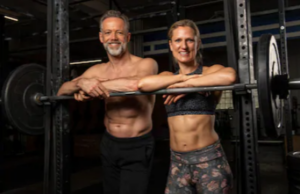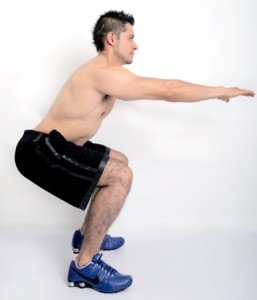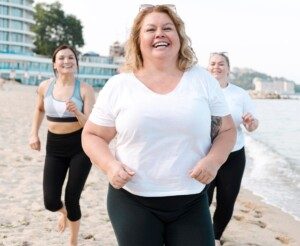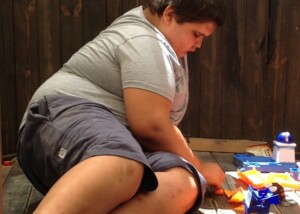It’s common for parents of severely autistic kids to worry “who’s going to take care of them after we’re gone”?
Here’s how to live longer and stronger.
You’ll live longer, as far as medical likelihood, if you work out hard, avoid smoking, drink little to no liquor and make a concerted effort to eat nutrient-dense foods and very few ultra-processed foods.
Now of course, if you’re as fit as a fiddle at age 70, can still climb stairs without problems at 80, and are still kicking hard at 90, there’s a good chance you’ll die before your autistic child does – assuming that you have done all you can to ensure that they are as healthy and as fit as they can be.
Autistic people need not be “high functioning” to be capable of a degree of exercise that makes them very fit.
Jeff and Will Marinac are identical twins with pronounced autism who have limited verbal skills and communicate via an iPad’s pictorial squares.
Yet they have hiked like demons, summiting numerous mountains.
These exceptionally fit autistic twins are just one example of how Autistics with high support needs can participate in activity enough to generate notable fitness results.
But very unfortunately, the vast majority autistic adults with higher support needs are in sad physical condition.
So it’s possible that their parents will outlive them. However – and there’s just no gracious way to put this – but whenever I see a very deconditioned autistic adult … the parents are in the same boat.
This doesn’t surprise me, because people who don’t place a high premium on physical fitness typically won’t pass that on to their children.
This holds true in the mainstream or typical world as well.
However, a typically-developed adult is much more likely to discover the importance of physical fitness on their own, than is someone with autism – and especially if that autistic person has an intellectual disability co-occurring with the autism.
Jeff and Will are intellectually challenged – a separate diagnosis from their autism – yet can hike as deftly as any neurotypical, college educated adult.
I’d love to see the parents of a 23-year-old autistic and intellectually challenged man I’ve seen several times now at the climbing gym.
This guy is BUFF. This doesn’t happen by accident.
I’m a lifelong gym rat and also a former personal trainer, so I know that nobody gets a buff physique by accident.
I asked his provider if he worked out, because climbing simple routes will not give you a buff body.
Sure enough, the provider told me that the slender but muscular young man, who’s nonverbal, trains with weights – “with prompts” and supervision.
I’ll bet his parents regularly exercise and have the look of fitness.
Years ago I regularly attended a particular gym and would often see a young man with Down syndrome who had a buff body.
I’d say to myself, “I don’t know who his parents are, but I’ll bet the farm they’re fit as f*ck.”
Eventually I saw his father at the gym, and sure enough, Dad was built like a marine.
If your child has a more severe presentation of Autism Spectrum Disorder, one of the best things you can do for them is get your own body whipped into shape.
Even if their disability prevents them from being capable of effectively exercising to the point of generating a respectable degree of fitness – the parent still should make a concerted effort to be physically fit and strong themselves!
The lack of fitness, the amount of deconditioning, that I’ve observed among the parents of very “out of shape” autistic teens and adults is nothing short of unsettling.
Having an Autistic Child Is All the MORE Reason to Exercise

Freepik
If you can’t make time for workouts, you’ll eventually have to make time for illness.
One might argue that taking care of a “profoundly” autistic child doesn’t leave time for exercise and also causes physical drain.
But certainly, many of these autistic adults are no longer living at home; they are in a host home setting.
Or, if they’re still living with their parents, they’re in a day program.
Somewhere, somehow, the parents can find the time – if they want it badly enough – to get in some hardcore exercise sessions, even if they’re working full-time.
Truth is, most Americans – and this means those without disabled kids – don’t seriously work out.
They make all sorts of excuses, and “I don’t have time” tops the list.
This includes people without any kids for that matter, and even those who work only part-time.
- Americans just don’t want to hit the gym or hiking trails.
Another point: A workout regimen will also make the parent’s body fitter, and hence, not as susceptible to feeling drained or exhausted from managing their young or adult child’s needs.
Ideally, the parent of an autistic child should NOT wait until they’re grown up and in a day program or host home to begin working out.
Nevertheless, fitness and health benefits will still come to those who wait till middle age to begin taking their fitness and health seriously.

It’s not about appearance. It’s just that the body composition that results from training hard with weights and eating mindfully makes the physique look a certain way — not to mention be resilient in the most hectic tasks of daily living. Shutterstock/Jules43
However, the sooner you begin, the much better this will be for your body. You don’t want to wait till your body begins breaking down to start training hard.
No, Hours and Hours in the Gym Are NOT Necessary
Just three hours a week — when used with intention and intensity — can dramatically transform your body.
The key is maximizing effort. Intense strength training builds muscle, which increases resting metabolism and reshapes your physique.
Cardio, performed at a high intensity, torches calories, improves heart health and boosts endurance.
When combined, these two approaches create a powerful synergy: You burn fat, build lean muscle and increase overall energy levels.
If you’re not overweight, this does not exempt you from working out.
If you’re not overweight, this does not exempt you from working out.
I’ve seen thin parents who still looked sickly and frail because of lifelong sedentary habits and no regular weight-bearing activity.
- Yes, you CAN tell if someone’s “in shape” by their appearance.
- Body composition, which is quite visible unless someone is covered up, is indicative of fitness, stamina and durability.
Visible body composition — specifically a lower level of body fat and higher lean muscle mass — often indicates improved metabolic health, cardiovascular fitness, stamina and physical durability.

This man has a good body composition.
Studies show that lower visceral fat (the kind that surrounds organs) correlates with reduced risk of chronic disease (Després et al., 2008), while greater muscle mass enhances endurance and resilience (Wolfe, 2006).
Thus, a well-defined physique can reflect internal health, functional capacity and long-term physical performance potential.
And no, I’m not talking about a bodybuilder or strongman physique.
But we don’t want to have a “doughy” body, either! This type of body, typically marked by excess body fat and low muscle tone, often signals poor metabolic health plus quick fatigue from physical tasks and a higher risk of injury from doing those tasks.
High body fat — especially that visceral fat — is linked to increased risk of heart disease, insulin resistance and inflammation (Després, 2006; Karelis, 2008), reflecting diminished fitness, stamina and overall physical function.
A split of roughly 90 minutes of strength training and 90 minutes of high intensity cardio each week — broken into three or four focused sessions — is enough to trigger real results.
High intensity interval training (HIIT) in particular yields benefits far beyond the time spent exercising, continuing to burn fat for hours afterward (the “afterburn” effect).
Meanwhile, compound strength movements like squats, deadlifts and presses engage multiple muscle groups, making every minute count.

The deadlift: Pick it up, keep arms straight, stand upward to an erect position, then gently set the barbell down. The deadlift is for women as much as it is for men — a whole-body exercise that builds a strong lower back. Freepik/pressfoto
The limited time forces efficiency and consistency, which often leads to better adherence than long, aimless workouts.
With proper form, recovery and nutrition, you can make three high-effort hours a week enough to shed excess weight that slows you down and makes you tire quickly, plus firm up and strengthen your muscle, and enhance cardiovascular health.
It’s not about how much time you spend — it’s about how hard you work while you’re at it.
You owe it to your autistic kids to be as fit as a fiddle!
You owe it to your autistic kids to be as fit as a fiddle!
Being healthy and physically fit dramatically increases your chance of living a long life — of being actively around for as many years as possible for your grown autistic child.
See the article links below for more detailed information on how to get going with strength training and HIIT.
HIIT Q & A: High Intensity Interval Training All Questions Answered
 Lorra Garrick has been covering medical and fitness topics for many years, having written thousands of articles for print magazines and websites, including as a ghostwriter. She’s also a former ACE-certified personal trainer. In 2022 she received a diagnosis of Level 1 Autism Spectrum Disorder.
Lorra Garrick has been covering medical and fitness topics for many years, having written thousands of articles for print magazines and websites, including as a ghostwriter. She’s also a former ACE-certified personal trainer. In 2022 she received a diagnosis of Level 1 Autism Spectrum Disorder.
.










































